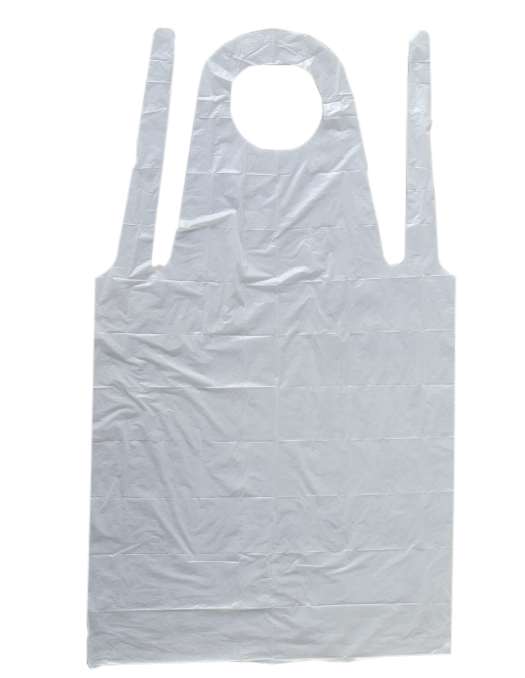Disposable Apron (PE) aprons are a great way to protect your clothes from messy jobs without the hassle of having to store and wash them afterward. After all, if you're going to have to wash everything again, why wear an apron in the first place? Instead, use a disposable apron to keep things clean, and just toss it in the trash when you're done. Made of a lightweight but protective polyethylene plastic, each disposable apron comes individually wrapped and ready to use. Just tie it on, and get to work without fear of getting a mess on yourself. Disposable aprons have numerous applications and are useful for projects ranging from food preparation to arts and crafts. Disposable aprons are a favorite among foodservice staff because they let them handle messy dishes without fear of ruining their uniforms that have to be worn each day. Disposable aprons are also water-resistant so that if something gets splashed on you while you're wearing one, you don't have to walk around with a wet spot all day. It's for this reason too that disposable aprons are great for kids--let the apron catch glue, paint, markers, Disposable Apron (PE), and other messes instead of their clothes.
Nexgen Whether you use them for business or pleasure, disposable aprons are a quick and easy way to keep messes under control. When you don't have the time to deal with the hassle of cloth aprons (and then sitting down to untangle all the ties), look to plastics. Disposable aprons are an affordable solution to a commonplace problem.

Disposable Apron for the food industry
A roll of disposable aprons is formed from an elongated strip of the plastic film having a portion along each side that is longitudinally folded over the remaining portion of the strip. The strip contains a plurality of latitudinal perforations at spaced intervals to enable the strip to be readily separated into discrete sheets. Each sheet has a cut-out portion near the top and is centered latitudinally in the sheet. Each sheet also has a cut-away portion on each side of the hole portion which begins on the outside edge at the top of the strip, then runs inwardly and downwardly, and then ends on the outside edge of the strip. The cut-out portion defines a neck opening and the two strips of the folded-over portions adjacent and inward of the cut-away portions define two waists tie straps. Disposable plastic aprons are typically manufactured from an elongated strip of plastic film. During the manufacturing process, the strip is repeatedly perforated and cut. The strip is then wound into a roll for shipping. At the point of use, individual sheets (each one constituting an apron) are pulled off the roll at the perforations.
Manufacturing Process
The apron is made of a plastic film having sufficient thickness and tensile strength to resist tearing. A wide variety of plastic film materials are suitable, including monofilms, monofilm/nonwoven laminates, spun-bonded and melt-blown nonwoven fabrics, and composite olefin fabrics. Plastic mono films are preferred because of their low cost. Examples of mono films include polyolefins, such as polyethylene and polypropylene, polyvinyl chloride, vinylidene chloride polymers, rubber hydrochloride, polyesters, and cellulose esters. Polyethylene is the preferred monofilm because of its physical properties and low cost. The plastic film typically has a thickness of about 10 to 250 μm (about 0.5 to 10 mils or thousandths of an inch) and preferably about 25 to 50 μm (about 1 to 2 mils). As the thickness decreases, both the strength of the apron and the costs of material decrease. If the thickness is less than about 10 μm, the apron is so lightweight that it tends to cling to the body rather than drape. As the thickness increases, the costs of material and
shipping increase.
